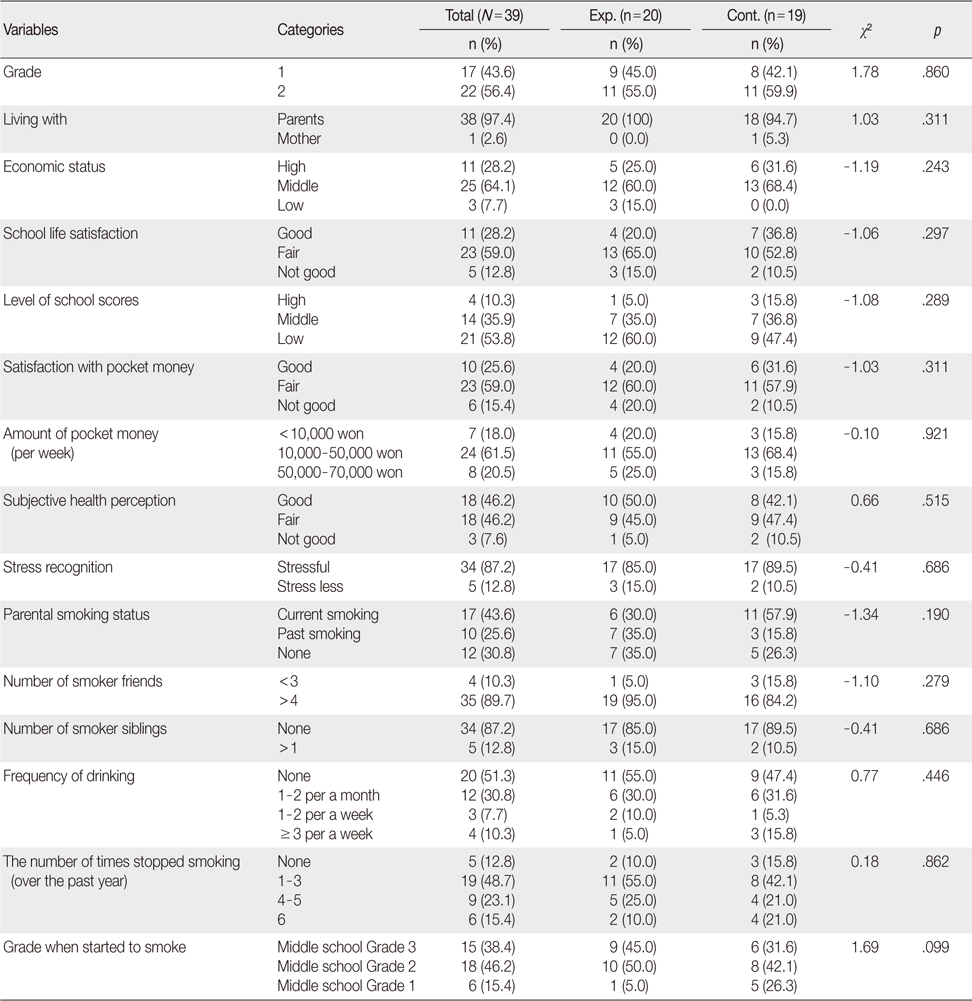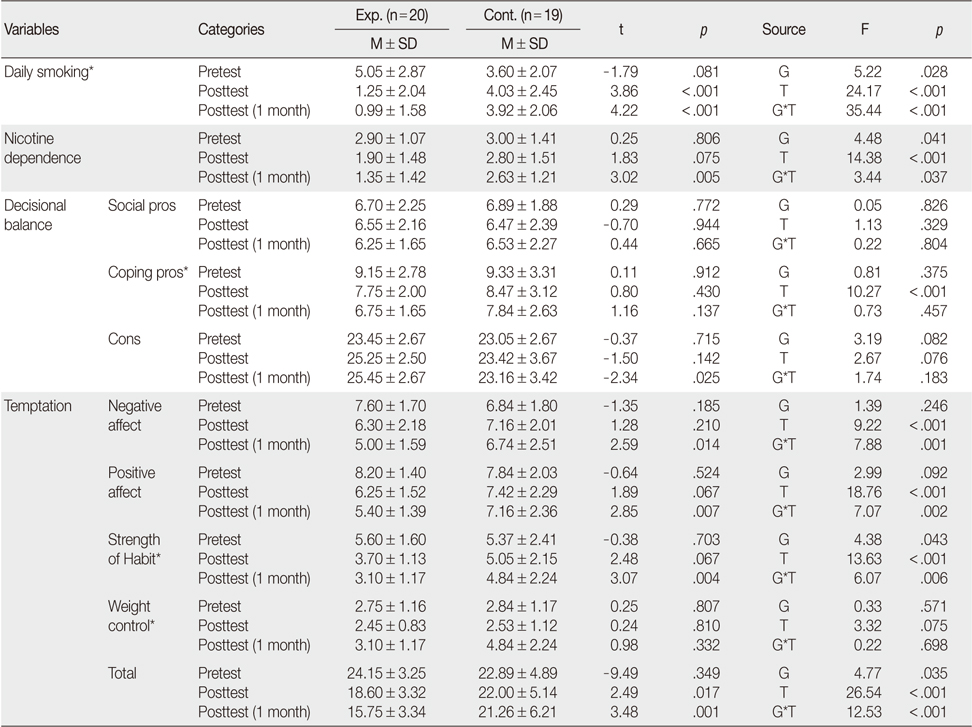Articles
- Page Path
- HOME > J Korean Acad Nurs > Volume 42(1); 2012 > Article
-
Original Article
- Effectiveness of a Motivational Interviewing Smoking Cessation Program on Cessation Change in Adolescents
- Young Sun Ha, Yeon Hee Choi
-
Journal of Korean Academy of Nursing 2012;42(1):19-27.
DOI: https://doi.org/10.4040/jkan.2012.42.1.19
Published online: February 29, 2012
1Doctoral Student, College of Nursing, Kyungpook National University, Daegu, Korea.
2Professor, College of Nursing, Kyungpook National University, Daegu, Korea.
- Address reprint requests to: Choi, Yeon Hee. College of Nursing, Kyungpook National University, 101 Dongin-dong, Jung-gu, Daegu 700-422, Korea. Tel: +82-53-420-4925, Fax: +82-53-421-2758, yeonhee@knu.ac.kr
© 2012 Korean Society of Nursing Science
- 1,038 Views
- 9 Download
- 13 Crossref
Abstract
-
Purpose
- This study examined the effectiveness of an Adolescent Motivational Interviewing Cessation program on smoking cessation change. The study was done with a nonequivalent control group pretest-posttest design.
-
Methods
- The participants were 39 high school students from G city, who were in school from September 1 to October 30, 2009. The students were assigned to the experimental group (20) and participated in the motivational interviewing cessation program or to the control group (19) who did not participate. Data analyses involved χ2-test, independent t-test, Repeated Measures ANOVA, and utilized the SPSS program.
-
Results
- The experimental group had significantly less daily smoking, nicotine dependence and smoking temptation in comparison to the control group. The experimental group had significantly higher stage of change in comparison to the control group.
-
Conclusion
- The results of the study indicate that a motivational interviewing cessation program delivered to adolescents who smoke is an effective method of encouraging cessation, and can be utilized as an effective nursing intervention for adolescents who smoke.
This article is based on a part of the first author's master's thesis from Kyungpook National University.
- 1. Byeon Y.S., Lee H.S. Relation of the blood pressure, lipids and body mass index by smoking status among adolescents. Journal of Korean Academy of Nursing. 2007;37:1020–1026.ArticlePubMedPDF
- 2. Chang S.O., Kim E.J., Kil S.Y., Seomun G.A., Lee S.J. Influential variables on intention and action to quit smoking between adoles cent smokers and adult smokers-Based on the transtheoretical model. Journal of Korean Academy of Nursing. 2005;35:1410–1419.ArticlePubMedPDF
- 3. DiClemente C.C., Prochaska J.O., Fairhurst S.K., Velicer W.F., Velasquez M.M., Rossi J.S. The process of smoking cessation: An analysis of precontemplation, contemplation, and preparation stages of change. Journal of Consulting and Clinical Psychology. 1991;59:295–304. http://dx.doi.org/10.1037/0022-006X.59.2.295.ArticlePubMed
- 4. Erol S., Erdogan S. Application of a stage based motivational interviewing approach to adolescent smoking cessation: The transtheoretical model-based study. Patient Education and Counseling. 2008;72:42–48.ArticlePubMed
- 5. Faul F., Erdfelder E., Lang A.G., Buchner A. G* Power 3: A flexible statistical power analysis program for the social, behavioral, and biomedical sciences. Behavior Research Methods. 2007;39:175–191.ArticlePubMedPDF
- 6. Hyun H.J., Ahn H.Y. An analysis of the research on effect of smoking cessation intervention. Journal of Korean Academy of Community Health Nursing. 2008;19:469–477.
- 7. Jeong L.S., Youn B.B., Pi S.Y., Kang Y.J., Lee S.H. Smoking status and nicotine dependency of general high school students in Seoul. Journal of the Korean Academy of Family Medicine. 1996;17:425–437.
- 8. Kim H.O., Jeon M.S. The relationship between smoking, drinking and the mental health in adolescents. Journal of Korean Academy of Public Health Nursing. 2007;21:217–229.
- 9. Kim S.Y., Seo M.A., Nam G.A., Lee H.H., Park J.H. Development of school-based smoking cessation program for Korean smoking adolescents. Journal of Korean Academy of Psychiatric and Mental Health Nursing. 2002;11:462–473.ArticlePDF
- 10. Kim Y.K., Park I.H., Park J.S. Meta-analysis of effects on adolescent smoking cessation programs in Korea. Journal of Korean Academy of Nursing. 2008;38:204–216.ArticlePubMed
- 11. Kohler C.L., Schoenberger Y.M., Tseng T.S., Ross L. Correlates of transitions in stage of change for quitting among adolescent smokers. Addictive Behaviors. 2008;33:1615–1618.ArticlePubMed
- 12. Korea Centers for Disease Control & Prevention. 5th youth health behavior research online. 2010;Seoul, Korea Centers for Disease Control & Prevention. (ISSN 2005-2456).
- 13. Lawendowski L.A. A motivational intervention for adolescent smokers. Preventive Medicine. 1998;27:A39–A46.ArticlePubMed
- 14. Lee C., Ko B.S., Lee M.S., Lee M.Y. Effect of attitude of parents and school on smoking status in high school students in a small city. Journal of the Korean Academy of Family Medicine. 2006;27:278–287.
- 15. Lee H.S. A study on effective of vocational high school students' smoking cessation program operation: Focused on the transtheoretical model. Journal of Korea Community Health Nursing Academic Society. 2004;18:205–217.
- 16. Lim E.S., Lee C.Y., Lee Y.J., Kim J.A. Effects of "5&6 smoking cessation program" on perception, behavior, and physiology of high school smokers. Journal of Korean Society for Health Education and Promotion. 2007;24(4):115–130.
- 17. Lim Y.S., Lee J.H., Kim S.I., Ham J.S. Adolescent smoking behavior: Personality, motivation, nicotine dependence. Korean Journal of Youth Studies. 2003;10:461–479.
- 18. Miller W.R. Jo S.H. Sin S.K . Enhancing motivation for change in substance abuse treatment. 2007;U.S. Department of Health and Human Services. (Original work published 1999).
- 19. Miller W.R, Rollink S. Jo S.H. Sin S.K . Motivational interviewing: Preparing people for change. 2006;New York, NY, The Guilford press. (Original work published 2002).
- 20. Pallonen U.E., Prochaska J.O., Velicer W.F., Prokhorov A.V., Smith N.F. Stages of acquisition and cessation for adolescent smoking: An empirical integration. Addictive Behaviors. 1998;23:303–324.ArticlePubMed
- 21. Park N.H. Predictors of stage of change for smoking cessation among adolescents utilizing the transtheoretical model. 2002;Busan, Pusan National University. Unpublished doctoral dissertation.
- 22. Plummer B.A., Velicer W.F., Redding C.A., Prochaska J.O., Rossi J.S., Pallonen U.E., et al. Stage of change, decisional balance, and temptations for smoking: Measurement and validation in a large, school-based population of adolescents. Addictive Behaviors. 2001;26:551–571.ArticlePubMed
- 23. Prokhorov A.V., Pallonen U.E., Fava J.L., Ding L., Niaura R. Measuring nicotine dependence among high-risk adolescent smokers. Addictive Behaviors. 1996;21:117–127.ArticlePubMed
- 24. Slesnick N., Meyers R.J., Meade M., Segelken D.H. Bleak and hopeless no more. Engagement of reluctant substance-abusing runaway youth and their families. Journal of Substance Abuse Treatment. 2000;19:215–222.ArticlePubMed
- 25. Velicer W.F., DiClemente C.C., Prochaska J.O., Brandenburg N. Decisional balance measure for assessing and predicting smokingstatus. Journal of Personality and Social Psychology. 1985;48:1279–1289.ArticlePubMed
- 26. Velicer W.F., DiClemente C.C., Rossi J.S., Prochaska J.O. Relapse situations and self-efficacy: An integrative model. Addictive behaviors. 1990;15:271–283.ArticlePubMed
REFERENCES
Figure & Data
REFERENCES
Citations

- An interventional study to assess the impact of behavior modification therapy on motivation level for tobacco cessation among adult tobacco users in a resettlement colony of South Delhi
Richa Gautam, Yasir Alvi, Farzana Islam, Nitesh Kumar, Rambha Pathak, Rashmi Agarwalla, Meely Panda, Ekta Gupta, Mamta Parashar, Rashmi Prakash Dayal
Journal of Education and Health Promotion.2024;[Epub] CrossRef - Development of a Motivational Interviewing Oral Health Education Program for Elementary School Students
Yi-Seul Kim, Soon-Ryun Lim
Journal of Dental Hygiene Science.2024; 24(4): 274. CrossRef - Smoking cessation and its significant role in the Indian scenario
Raj Kumar, Manoj Kumar, Sukriti Raj, Dileep Kumar Arisham, Anil Kumar Mavi, Kamal Singh
Monaldi Archives for Chest Disease.2023;[Epub] CrossRef - A Prospective Study to Assess the Outcome of Motivational Interviewing Among Male Students of Haryana, India: A Strive Towards Smoking Cessation in the Youth
Virinder S Gill, Neha Chaudhary, Avneet Randhawa, Manisha Verma, Gurleen K Rai, Shradha Mishra
Cureus.2022;[Epub] CrossRef - The effect of Transtheoretical Model based motivational interviewing on smokeless tobacco cessation in high school students
Filiz Taş, E. Ümit Seviğ, Zeynep Güngörmüş
Journal of Substance Use.2020; 25(6): 639. CrossRef - Motivational interviewing for smoking cessation
Nicola Lindson, Tom P Thompson, Anne Ferrey, Jeffrey D Lambert, Paul Aveyard
Cochrane Database of Systematic Reviews.2019;[Epub] CrossRef - Affecting Nicotine Dependence of Social Psychological Variables in Smoking middle school
Young-Mun Cho, Mi-Young Woo
Journal of Digital Convergence.2016; 14(2): 295. CrossRef - Using the WHO ASSIST to Assess Drug and Alcohol Misuse in the Acute Mental Health Setting to Guide Treatment Interventions
Karen R. Heslop, Calum Ross, John Berkin, Dianne Wynaden
International Journal of Mental Health and Addiction.2015; 13(5): 618. CrossRef - Effectiveness of the Self-determination Theory based a Motivational Interviewing YOU-TURN Program for Smoking Cessation among Adolescents
Young Sun Ha, Yeon Hee Choi
Journal of Korean Academy of Nursing.2015; 45(3): 347. CrossRef - The effectiveness of a Autonomous Regulation Improvement Smoking Cessation Program on the Amount of Daily Smoking, Perceived Motivation, Cotinine in Saliva, and Autonomous Regulation for Girls High School Students who Smoked
Young-Sun Ha, Yeon-Hee Cho
Journal of the Korea Academia-Industrial cooperation Society.2015; 16(9): 6169. CrossRef - Effectiveness of a Secondhand Smoking Prevention Program on Adolescents
Min Ah Park, Mi Ye Kim, Young Sun Ha
Journal of Korean Academy of Community Health Nursing.2014; 25(1): 44. CrossRef - Efficacy of Smoking Cessation and Prevention Programs by Intervention Methods: A Systematic Review of Published Studies in Korean Journals during Recent 3 Years
Hye Kyeong Kim, Ji Yeon Park, Eun Joo Kwon, Seung Hee Choi, Han-Ik Cho
Korean Journal of Health Education and Promotion.2013; 30(5): 61. CrossRef - Influencing Factors on Smoking Cessation Motivation of Adult Males
Young Mi Yoon, Eun Kyung Yang, Sung Rae Shin
Korean Journal of Adult Nursing.2012; 24(5): 520. CrossRef
Homogeneity Test for General Characteristics between Groups
Exp.=Experimental group; Cont.=Control group.
Homogeneity Test for Smoking Behavior, Decisional balance, Temptation between Groups
Exp.=Experimental group; Cont.=Control group.
Homogeneity Test for Stage of Change between Groups
Exp.=Experimental group; Cont.=Control group.
Smoking Behavior, Decisional balance, Temptation between Groups according to the Time Intervals
*Greenhouse-Geisser.
Exp.=Experimental group; Cont.=Control group; G=Group; T=Time.
Stage of Change between Groups
Exp.=Experimental group; Cont.=Control group; PC=Precontemplation; C=Contemplation; P=Preparation; A=Action.
Exp.=Experimental group; Cont.=Control group.
Exp.=Experimental group; Cont.=Control group.
Exp.=Experimental group; Cont.=Control group.
*Greenhouse-Geisser. Exp.=Experimental group; Cont.=Control group; G=Group; T=Time.
Exp.=Experimental group; Cont.=Control group; PC=Precontemplation; C=Contemplation; P=Preparation; A=Action.
 KSNS
KSNS
 E-SUBMISSION
E-SUBMISSION





 Cite
Cite

